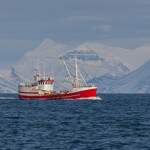New campaign to refresh marketing, supply chain efforts in Russia
With 2018 nearing its end, the Russian Agency for Fisheries has announced that this will be the second consecutive year Russian catch totals reach an all-time high. When all is said and done for 2018, Russian fishing companies are expected to have landed more than five million metric tons (MT) of fish, up from 4.9 million MT in 2017.
Yet even as Russian fishing companies catch more fish than ever, the country’s per capita consumption of seafood has been decreasing. The price of fish has risen steadily, and the country’s economy has dipped as it contends with international sanctions imposed after its annexation of Crimea. Furthermore, a generational shift in food preferences, and transportation issues that are making it difficult to bring fresh fish to market, have also hurt Russian seafood consumption.
In response, the Russian Agency for Fisheries has launched “The Russian Fish,” a marketing and supply chain initiative designed to bring a new approach to the country’s seafood industry. According to the agency’s director, Ilya Shestakov, who was speaking during a meeting with retailers earlier this year, the effort will be multi-faceted and will attempt to bring the government, fishermen, and traders together to conduct joint marketing campaigns.
The Federal Agency for Fisheries is establishing a non-profit organization – also named "The Russian Fish" – to coordinate the campaign, according to Shestakov. The organization’s functions will include market analysis and establishing industry standards for the catching, storage, transportation, merchandizing, and selling of fish in Russia and abroad. Initially, The Russian Fish will concentrate on four sectors: White fish, salmon, pelagic species, and shellfish, according to Shestakov.
Shestakov said his agency is encouraging private-sector producers and retailers to take part in the nonprofit, and that his agency has already reached out to 15 to 20 major fishing companies, seafood trading firms, and retails chains to become part of The Russian Fish’s initial membership group.
The industry needs to develop standards for each part of the supply chain to deliver seafood to consumers as quickly – and therefore as fresh – as possible, Shestakov said. In order to streamline this effort, Shestakov said he would like to see a decrease in the number of intermediaries in the supply chain. Ideally, Shestakov said, he would like to see the number of parties involved in the supply chain to just two: the fishing company and the retailer.
But there are some obstacles in achieving that objective, according to Russian Federal Agency for Fisheries Deputy Head Pyotr Savchuk. Most of Russia’s fish is caught in the Russian Far East, while much of its population is in the European part of Russia, thousands of kilometers away. The logistics of bringing fish from one end of the country to the other currently requires the involvement of many parties, from fishing companies to wholesalers, transport companies to retailers. Furthermore, existing rules and guidelines on transportation, packaging, and merchandising are often not obeyed, Savchuk said.
Despite the obstacles, Russia’s Federal Agency for Fisheries has set the goal for The Russian Fish campaign of increasing overall seafood sales – including domestic sales and exports – by five percent a year starting in 2019, Savchuk said. To hit the domestic target, significant improvements must be made on the marketing front, he said, as current efforts are poorly coordinated and not driven by data. Savchuk encouraged shops and supermarkets to emphasize Russian-caught fish, touting its local origin and its health benefits. He also called for a campaign to educate consumers about less popular species.
“Our focus is to meet demands of consumers,” Savchuk said in his speech at the II Global Fishery Forum in St. Petersburg in September. “Today, consumers want fillet[s]. They don’t want to spend much time on cooking fish and deal[ing] with frozen, ungutted fish. We need to explain to people the benefits of eating fish and how to cook it.”
Polina Kirova, the business development director at Rybset, a retail and wholesale fish chain, told SeafoodSource efforts to align and improve marketing for Russian-produced fish are already underway. Kirova noted research shows more than 50 percent of food in Russia is sold via retail chains, according to a market survey by marketing consultancy firm InfoLine. This shows retail should be the focus of future seafood marketing campaigns, Kirova said.
Direct sales are curbed by the fact that most fisheries don’t have their own logistics capacities, Maria Filippova, the public relations and group manager for Russian retail group Lenta, told SeafoodSource. Nonetheless, she backs the push to shorten the supply chain.
”[It’s] one of the most promising ways to reduce the retail price for seafood on [the] shelf and guarantee a high-quality level of product,” Filippova said.
Stanislav Naumov, the general manager of the X5 Retail Group, one of the biggest retail companies in Russia, agreed. X5 has developed eight private labels for seafood in 2018 after signing direct supply contracts with fishing firms. For its part, Lenta has signed four such agreements.






Share